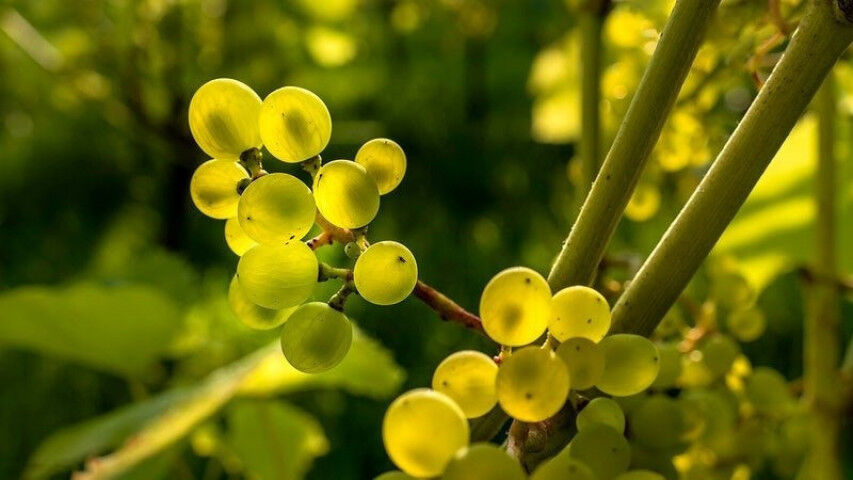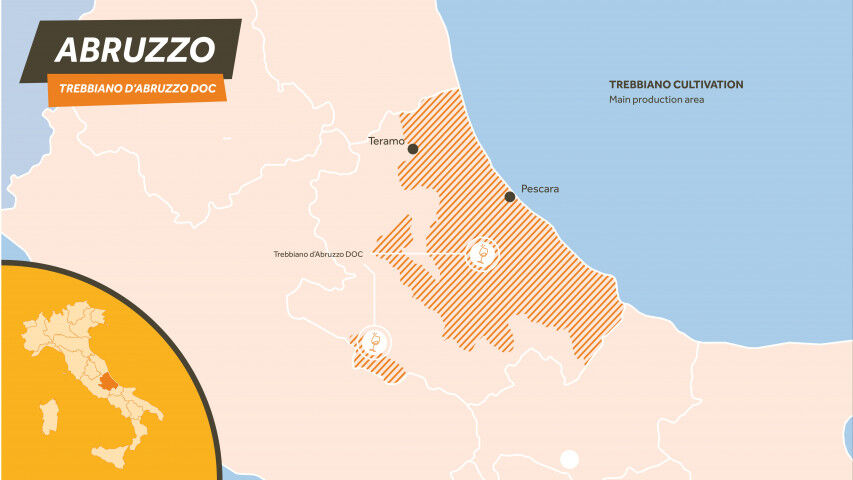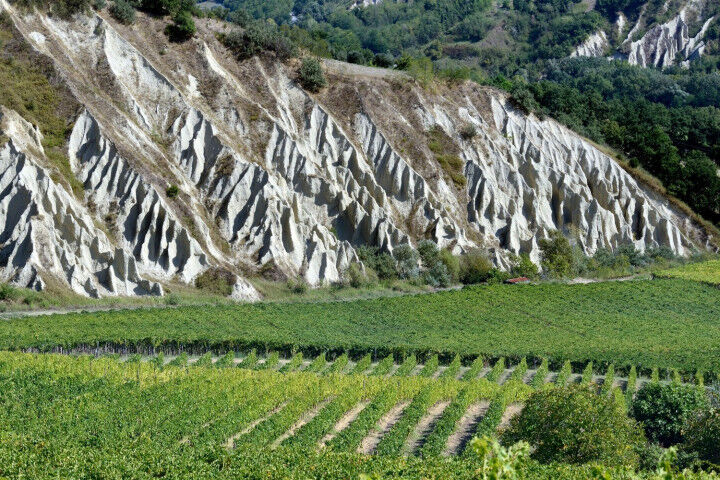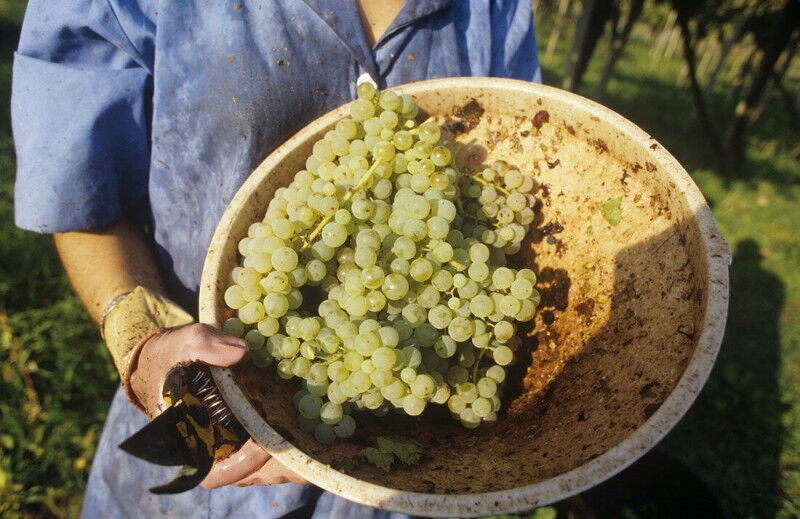Trebbiano in 30 seconds
- Trebbiano is one of the most common white grapes in Italy, producing approximately one-third of white wine in the country.
- It’s a fairly neutral variety with a fresh, fruity profile.
- It grows quickly and easily, producing high yields.
- It appears in around 80 DOCs across Italy.
- It has seven unique named DOCs including Trebbiano d'Abruzzo and Trebbiano di Soave.
- It’s particularly renowned in Umbria where it’s used in the Orvieto blends with other local white grapes.
- It can also appear in some red blends.

Learn about Trebbiano
Trebbiano is a vigorous grape family that grows all over Italy. For this reason, it can be hard to get your head around Trebbiano as the name encompasses a wide and occasionally unrelated, group of white cultivars that hail from Italy and also appear in France. Here’s it’s known as Ugni Blanc and plays a key role in the production of Cognac. While more than 95% of Trebbiano grows in Italy, beyond Europe, small quantities also grow in the US and South America.
Where does Trebbiano come from?
Naturally, this unwieldy grape dynasty has been much studied by ampelographers! They’ve discovered DNA that shows, indeed, there are numerous unique types of Trebbiano that have tenuous links to other grapes in the group ̶ or even no links at all. Whatever their strain though, Trebbiano grapes do share a few features in common. They are all white varietals and fruit is commonly late ripening. What’s more, the vines are robust and can thrive in a range of terroirs.
In Italy, the most significant plantings in the center and the south of the country and the most common type is known as Toscano Trebbiano. Emilia-Romagna accounts for the greatest quantity of this white grape followed by Puglia, and Abruzzo.
Trebbiano is a very popular grape for Italian table wines because its fresh, vibrant fruity notes make it ideal for early drinking. It appears as the dominant grape in numerous white DOC blends and sometimes adds vibrancy to Tuscan red Carmignano wine. A standout DOC is Orvieto where this grape is blended with Grechetto and Canaiolo Bianco. Notable DOCGs that feature Trebbiano include Frascati Superiore and sweet Cannellino di Frascati.

Is Trebbiano sweet or dry?
This popular grape displays notes of peach, green apple, and lemon, with hints of minerality and fresh herbs. It’s made in still, dry styles and features refreshing high acidity and a touch of bitter almond on the finish. Alcohol levels range from 11.5% to 13.5%.
It also plays a role in Superiore and sweet styles. In short, with its light, crisp character and in spite of its high-volume production, Trebbiano really punches above its weight with compelling aromas and flavors.
The majority of Italian wine made from Trebbiano family grapes is in a still, dry style. Frascati Superiore is, as its name suggests, a more refined quality of dry white wine that’s dominated by Malvasia grapes and can contain Trebbiano.
Sweet Cannellino di Frascati is a gently sweet wine made from late-harvest fruit partially affected by botrytis. Malvasia is the main grape with up to 30% of the blend made up with specific white grapes that can include Trebbiano.
In France, Trebbiano’s sister, Ugni Blanc is used in brandy and cognac production.
This popular grape displays notes of peach, green apple, and lemon, with hints of minerality and fresh herbs. It’s made in still, dry styles and features refreshing high acidity and a touch of bitter almond on the finish.
Alcohol levels range from 11.5% to 13.5%. It also plays a role in Superiore and sweet styles.
In short, with its light, crisp character and in spite of its high-volume production, Trebbiano really punches above its weight with compelling aromas and flavors.

What food does Trabbiano pair with?
Trebbiano is a light, refreshing, dry white wine that’s versatile and food-friendly. Its acidity works well with creamy and fatty food, but it also pairs with a range of light dishes that are traditionally suited to delicate white wines. Just avoid spicy food as the wine’s acidity will create an unpleasant burning effect. Naturally, the sweeter wines that feature Trebbiano match an entirely different food spectrum. Read on for inspiration!
As a dry white wine, Trebbiano pairs well with hard Italian cheeses, seafood pastas, white pizza, roast chicken, and even pesto-rich dishes.

Trebbiano Food Pairing
Trebbiano DOC and Frascati Superiore
Appetizers
- Vinegar-marinated sardines;
- Bruschetta;
- crab cakes
- cured meats
- olives
Meat and Fish
Vegetarian/ Vegetables
- Roast vegetables;
- pasta dishes with vegetable-based sauces or light creamy sauces;
- anything recipe with green or red pesto.
Cheese
- Parmigiano-Reggiano;
- Ricotta; Fontina;
- Taleggio.
Cannellino di Frascati
Owing to its delicately sweet palate, this wine pairs well with lightly spicy recipes. It also pairs well with Pecorino Romano or blue cheeses.
Desserts
- Panna cotta with forest fruit;
- fruit cobbler;
- apple tart.

What are the main Trebbiano regions of Italy?
As already mentioned, the Trebbiano family of grapes appears in scores of appellations across Italy, usually as the dominant grape in a blend. It’s also found in lesser quantities in some outstanding blends. Let’s take a look at some of the better-known wines.
Orvieto DOC
The best-known wine of Umbria, Orvieto DOC is a blend of Trebbiano (here known as Procanico) and Grechetto. The combination of these two grapes must comprise at least 60% of the blend. The remaining 40% can be a range of permitted white grapes. These dry wines display peachy notes on a crisp palate featuring mild acidity.
Orvieto DOC also has a Classico area where superior fruit produces higher quality wines in the same style.
Frascati Superiore
Frascati Superiore DOCG is produced southeast of Rome in the northern reaches of the Colli Albani Hills. Malvasia makes up a minimum of 70% of the blend with permitted white grapes, including Trebbiano, making up the remaining 30%.
Made under stringent DOCG regulations, this straw-colored wine is dry, perfumed, soft, and elegant.
Cannellino di Frascati
Cannellino di Frascati is a gently sweet DOCG wine from Lazio. It’s made from late harvest, botrytized grapes with rich flavors and concentrated sugars. This wine is a blend of 70% Malvasia and up to 30% other white grapes including Trebbiano.
The aroma and flavor profile of this wine boasts fine fruit aromas in a sweet palate.

What is the origin of Trebbiano?
As with many Italian grapes, searching for the origin of Trebbiano takes us on a journey around Europe (and beyond) but its definitive roots have not been determined. Some researchers are convinced it hails from the Middle East and ended up in Italy after traveling to Greece then North Africa during the Roman Empire. Sub-types of Trebbiano appeared in 13th-century Bologna and France indicating how widely traveled and cultivated it is!
Where does the best Trebbiano come from?
In Italy, a type of Trebbiano is very common in Tuscany (Toscano Trebbiano we’ve already met) and in Umbria where it’s called Procanico. Lazio, the home of Frascati, is also a popular area for Trebbiano.
Italian DNA research from 2008 indicated a firm connection between Garganega and Trebbiano but the research is not conclusive. The plot thickens when you add to the equation DNA analysis that shows common genes in Trebbiano and Alionza, an Emilia-Romagna wine grape.
Wherever Trebbiano comes from, it contributes significantly to Italian wine across simple, fresh table vinos and distinct appellations.

How is Trebbiano made?
Still Dry Trebbiano
This grape has delicate fruit so the objective in winemaking is to preserve these flavors. This, more often than not, means anaerobic processes. In other words, fermentation is in stainless steel rather than oak to protect the fresh fruit characteristics.
Additionally, the wine is fermented dry so there is minimal residual sugar, giving it a crisp bite. It’s also made for early drinking so is released into the market young.
Frascati Superiore DOCG
The terms “DOCG” and “Superiore” on a wine label indicate that there are tighter production standards leading to better-quality wine. In the case of Frascati Superiore, yields are lower than for regular wines and alcohol is higher. The result is richer, more powerful wines with flavor concentration.
Cannellino di Frascati
The key to making these wines sweet is in the vineyard. Grapes are left on the vine longer in order to accumulate greater sugar and flavor intensity. Autumn conditions also promote the development of noble rot or botrytis. This “friendly” fungus aids in further concentration of flavors and sugars and also adds its own unique notes to the finished wine – which is richly fruity and delicately sweet, yet fresh.

What Kind of Wine is similar to Trebbiano?
- Pinot Grigio, Italy.
- Unoaked Chardonnay (international moderate-climate style).
- Soave, Italy.
- Muscadet, France.
- Airen, Spain.
Interesting facts about Trebbiano
- Trebbiano is used in the production of Balsamic vinegar.
- It’s also used in Cognac and Armagnac.
- It shares three synonyms with the white Spanish cultivar, Viura.
- In France, Trebbiano is known as Ugni Blanc.
- Like many Italian grapes, Trebbiano came to Argentina with Italian immigrants.
You might be interested in:

all.sign in to leave a review









